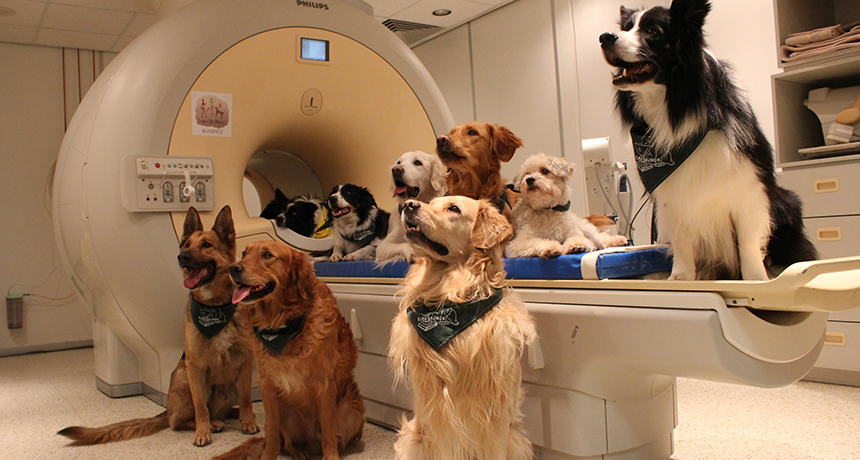Good dog! Canine brains separate tone of speech from its meaning
Like human brains, those in dogs process both what something means and how it’s said

To see how dogs process speech, researchers trained these pooches to sit still while an MRI device scanned their brains. As it turns out, dogs are a lot like people.
ENIKŐ KUBINYI
As parents love to say, “It’s not just what you say, but how you say it.” Now, a new study shows that the same applies to dogs. Our furry friends process speech much as people do. They can differentiate the tone of voice from the meaning of words.
Meaningful words or phrases, like “good boy,” activate the right side of a dog’s brain no matter how they’re said. But the brain processes the tone of voice used to speak a word or phrase on its left side.
The same is true in people, although the side of the brain that is activated is reversed. We process what something means using the left hemisphere of our brains. And we interpret the tone in which it’s spoken using the right side. This process allows us to distinguish words with meaning from random sounds. But researchers didn’t know whether that division of labor in the brain evolved before or after people acquired language, says Attila Andics. He’s a neuroscientist at Eötvös Loránd University in Budapest, Hungary.
Dogs have a close connection to people. That makes them ideal for testing how they process speech. “Humans use words towards dogs in their everyday, normal communication,” Andics points out. “And dogs pay attention to this speech in a way that cats and hamsters don’t.”
He and his team trained dogs to lie very still. Then they scanned the animals’ brains using a functional MRI (fMRI) machine. It shows when and where a brain responds as signals come in. During the scan, the scientists played the dogs the recorded voice of a trainer. This person spoke meaningful praise words, such as “good girl,” or neutral words, such as “however.” The tone of voice used could be either neutral or enthusiastic.
The dogs showed increased activity in the left side of their brains when they heard the meaningful words but not the neutral ones. Meanwhile, an area on the right side of their brains reacted to the tone used with the words. It could separate out those spoken enthusiastically from those spoken without emotion.
The combination of both praising words and an enthusiastic tone of voice caused the reward center — a part of the brain associated with getting something pleasing — to become more active. That means that the dogs had the same neurological response to an excited “Good dog!” as they might to being petted or receiving a treat. When praise words or an enthusiastic tone were used separately, they didn’t have the same effect.
Andics and his team described their findings in the Sept. 2 Science.
The role of language
Use of language separates people from other animals. Humans are the only species to manipulate precise sequences of sounds to convey different meanings. But the new study suggests that the ability to hear these random sequences of sound and link them to meaning isn’t exclusively human.
“I love these results,” says Laurie Santos. She’s a cognitive psychologist who works at Yale University in New Haven, Conn. The new findings “point to how well domestication has shaped dogs to use and track the very same cues that we use to make sense of what other people are saying,” she says.
Domestication has made dogs more attentive to human speech. But people and dogs have been close companions for only about 30,000 years. That’s just not long enough for dogs to have evolved complicated language-processing skills that use both sides of the brain, says Andics. So the trait must go back far earlier. He suspects it comes from some older neural technique used to make sense of meaningful sounds. And he believes it is not limited to humans and dogs.
Unfortunately, testing this in other species — even pets — could prove difficult. Why? Cats, he notes, don’t take as kindly to being put inside fMRI scanners and asked to hold still.
Correction: The side of the brain that is affected in dogs has been corrected for an error that the authors had introduced into their original paper. The authors posted a correction in the April 7 issue of Science. The lead author, Attila Andics, says his team’s major finding still stands: that dogs process different aspects of human speech on different sides of their brains.







